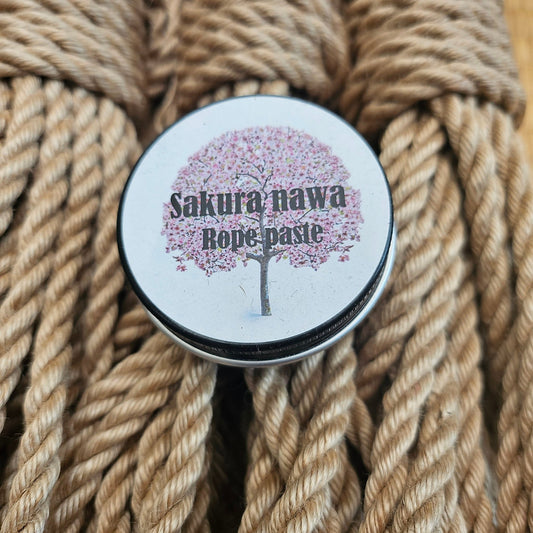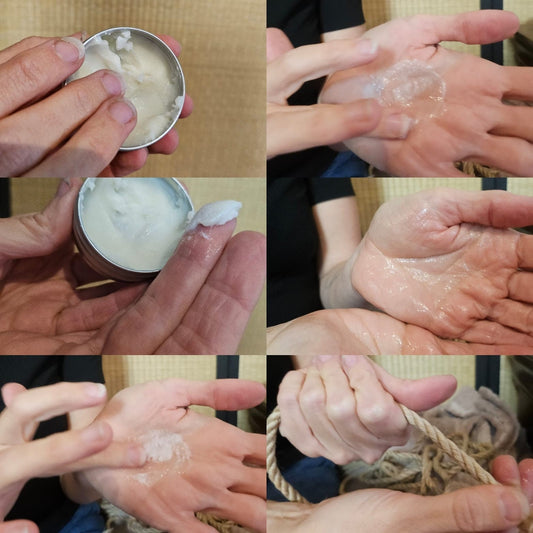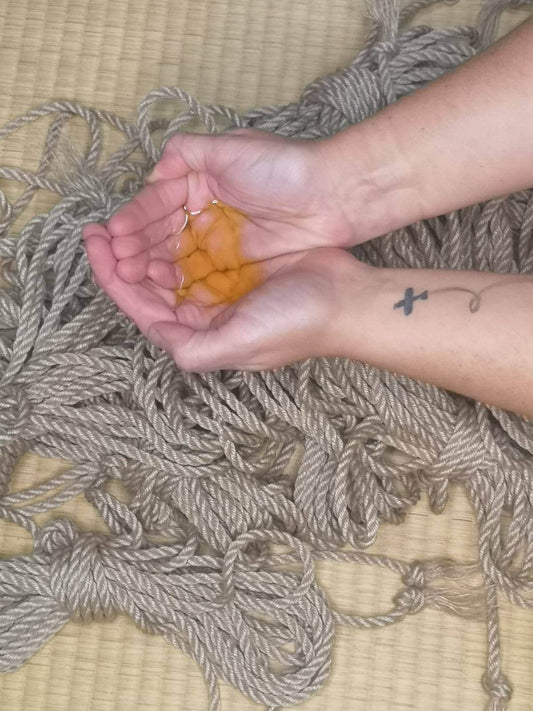Jute - Care
I sell both raw untreated Jute ropes, and fully treated ropes. No matter where you get your ropes from this guide goes over all you need to know to maintain your rope in tip top condition.
Collapsible content
1. Energy
The process of rope yarns being twisted in one direction, then twisted in the other as they form the rope, can leave ropes with a lot of energy and spin. To minimise this, lightly pinch the rope at one end with your thumb and finger, and pull the rope all the way through. Then, repeat this in the opposite direction. I do this myself with my ropes after each rope session.
2. Fuzzies
I remove the majority of the fuzzies before shipping the rope by gently beating the ropes for 24 hours. This process also softens the ropes. I do this using a specially adapted tumble dryer - DO NOT TRY TO DO THIS AT HOME, Tumble drying rope at home can result in fibres over heating and catching fire.
However, some fuzzies remain, and the rope is likely to shed some fibres when used. This will become less and less with use. If you wish to remove the remaining fuzzies—at your own risk—this can be done by running a blue flame over the rope. This should be done in a well-ventilated area, and must be done at a reasonable speed or you risk setting fire to your rope. If any area of your rope is left over a flame for too long, it will damage the integrity of the rope and make it more prone to breaking when under a load. Once complete, run a cloth over your rope to remove as much soot as you can (some people use a cloth with a little vodka or sake on it to help remove the soot). This process will darken the rope and leave a slightly smoky smell, which some people love and some people hate.
|
|
|
|
Breaking in Rope
The process I use to treat rope softens the rope prior to shipping, but a number of people recommend 'breaking in' Jute rope before using it.
Step three is actually...DON'T ARTIFICIALLY BREAK IN YOUR ROPE!
With use Jute rope becomes highly polished as it rubs against itself which causes the rope to loose fibres. With time bondage rope thins, and the risk of breakages increases. When rope has thinned to much it should be moved to floor use only, or retired.
Many people recommend break in rope by rubbing it against itself. This is not something I recommend as it damages the rope and makes it more likely that you will break your rope.
How people break rope
The method people recommend is is placing a rope over a carabiner, ring, or piece of bamboo then twisting the rope so that one rope is wrapped around another, and then pulling the rope back and forth to soften it.

This means that the rope is rubbing against itself like sandpaper.
If you try this on a small piece of scrap rope you will see that as you pull the rope back and forth rope fibres will come of the rope and it will thin. The picture below shows two half's of the same rope which hasn't been treated with with rope paste . Rope paste and oils help protect ropes from just this kind of friction, you really don't want to be artificially creating situations in which your rope is being placed under unnecessary friction. . The one on the right has been repeatedly broken on the same spot - as you can see the lay has become a lot loser and the rope has become thinner. 
The thickness of the rope before it was broken was 6mm:

After repeatedly breaking the rope it is 4.36mm!!

Rope Oils, Pastes, and Waxes
I offer hand-oiling as an add-on treatment for all purchases of jute and hemp ropes, and I also offer rope paste made from shea butter here.
When rope rubs against other ropes or around objects, this has an abrasive effect. Adding an oil or wax to your ropes reduces the impact of this, and helps protect your ropes from microfractures. It can also improve the feel of the rope. If the rope is over-waxed or oiled, it becomes claggy and feels horrible, and there is little that can be done to correct this—so use rope oils and pastes sparingly.
Please note that rope which has been treated with oils, waxes, or pastes cannot be washed.
Oils: Everyone has a favourite oil for treating rope. My personal preference is jojoba as it is not a synthetic product and combines the attributes of oil and wax. To apply, pour a little onto your hands, rub your hands together, and then run your hands along the length of your rope in one direction, and then the other.
Rope Pastes: I use shea butter mixed with sakura. Application is the same as for oils: add a small amount to your hands, rub it in, and then run your hands along your rope.
Waxes: A mix of beeswax and oil is widely used for treating ropes. However, this is not a treatment that is suitable for vegans and not one that I sell. Some people who sell these treatments recommend applying them and then baking the rope in the oven to help the waxes penetrate throughout the rope. Please note this is not something that I recommend, as ‘cooking’ your rope may damage the yarns and reduce the strength of the rope.
Cleaning
The aim is to avoid needing to wash your rope. Ideally, you will never wash your rope and will instead just run a cloth over it to remove any dust or debris it has come into contact with. When jute rope gets wet, it swells, and if this happens in an uneven manner, either in the washing process or drying process, it will damage your rope.
Please note: Rope that has been treated with oil or wax cannot be effectively cleaned unless the rope is brought to a temperature that can separate out this oil or wax—and that carries the risk of damaging the rope fibres.
I am aware that some people recommend methods such as boiling ropes (for treating industrial ropes with high JBO content that smells like petrol) to remove some of these chemicals. It is unclear what impact heating jute rope in this way has on its strength. However, this process does cause JBO to be released into the air, which can cause respiratory collapse and death. Ropes should NEVER be boiled.
If you are in a situation where you have to wash your rope, either hand wash your rope at a low temperature or use a handwash setting with minimal spinning, and then hang your rope to dry with light pressure on either end of the rope to stretch it out a little as it dries. Please note that washing dyed ropes may cause colors to fade or run.

High Strand
bbb
Links to treatment options
-
Sakura nawa rope paste for jute/hemp treatment
Regular price £6.00 GBPRegular priceUnit price / per -
Vegan Rope treatment oil for jute/hemp, Jojoba. NOT A PHYSICAL ITEM
Regular price £0.55 GBPRegular priceUnit price / per

 Quickly pass the rope over the flame
Quickly pass the rope over the flame Before
Before After
After

